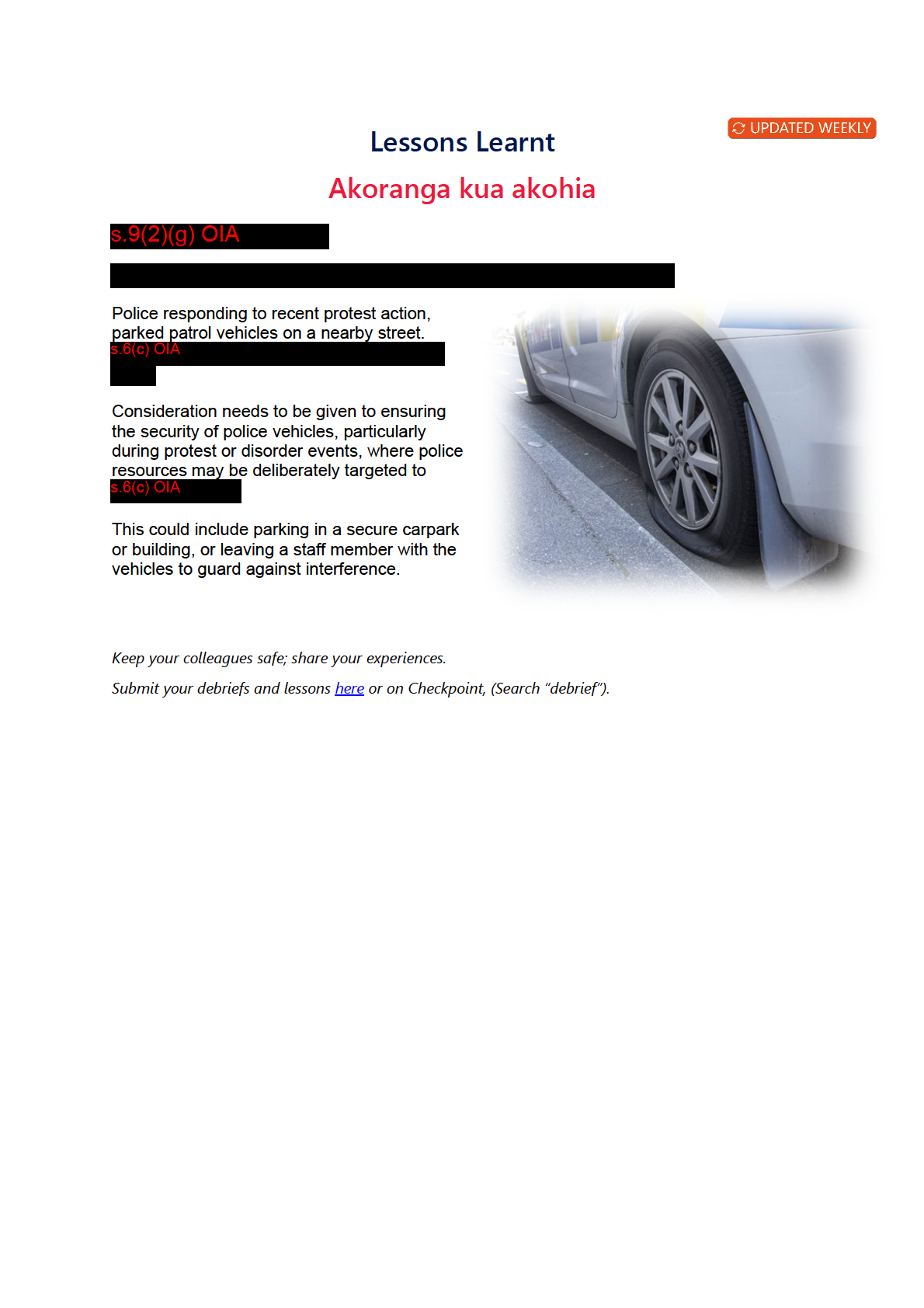 Lessons Learnt
Akoranga kua akohia
3D printed firearms
Lessons Learnt
Akoranga kua akohia
3D printed firearms
At a recent warrant in s.9(2)(g) OIA staff seized a 3D-printed s.6(c) OIA
(pictured below), along
with a range of other firearms and ammunition.
s.6(c) OIA
s.6(c) OIA
Most readily available 3D printers produce plastic parts. s.6(c) OIA
s.6(c) OIA
Staff searching premises should be aware of the possibilities of 3D printers being used to produce
firearms or weapon components and the additional threat this technology poses to safety.
Keep your colleagues safe; share your experiences.
Submit debriefs and lessons here or on Checkpoint (search “debrief”).


Lessons Learnt - Accidental Disclosure of Witness Information | Ten One - New Zeal...
Page 1 of 2
Lessons Learnt - Accidental Disclosure of
Witness Information
Lessons Learnt
02/06/2017
s.6(c) OIA
s.9(2)(g) OIA
The same day, the officer (a sergeant) explained the situation to members of s.9(2)(a)
team—highlighting his own mistake as an opportunity from which they could learn.
The local Professional Conduct manager, the District Commander and Police’s Chief
Privacy Officer were all notified.
The IPCA was satisfied with investigators’ subsequent decision that because of the
officer’s immediate actions in reporting and dealing with s.9(2)(a) mistake honestly and
promptly,
s.9(2)(a) Odisclosure of private information should be dealt with by way of
professional conversation only.
Lessons identified:
1. Disclosure of private/sensitive information is a significant risk for Police and
every possible effort must be made to minimise the possibility. Therefore, any
disclosure should be checked independently before sending. This is not because
staff are not trusted but purely out of recognition that it is impossible to eliminate
human error; people
will make mistakes.
2. In this case, the officer was not aware of the need to make a notification in the
Security and Privacy Incident Reporting Database (SPIRD) under “Notifications”
in the Bulletin Board and this was overlooked. Any security/privacy breach or
incident must be notified to the SPIRD as soon as possible.
https://tenone.police.govt.nz/news/lessons-learnt-accidental-disclosure-witness-inform... 29/08/2017
Lessons Learnt - Accidental Disclosure of Witness Information | Ten One - New Zeal...
Page 2 of 2
Comment:
It is highly unlikely this officer will ever make a similar mistake (s.9(2)(g) OIA
) However, the officer’s honesty and
courage in confronting
o
s.9(2)(a) OI
wn mistake, fronting up to those affected, and willingness
to uses.9(2)(a) O own mistake as a learning opportunity for
t
s.9(2)(a) OI eam, demonstrated integrity
and professionalism.
It is unavoidable that because the public (rightly) holds Police accountable for its
actions, incidents such as this must be investigated—as happened here—and officers
involved should expect to be investigated or reviewed by the likes of Professional
Conduct, the Privacy Office or the IPCA. However, where officers being investigated are
honest and open, and their initial actions were genuine mistakes (made with good
intent—and not either criminal or grossly negligent), they should have little to fear
from an objective investigation, as evidenced by comments from the Chief Privacy
Officer:
s.9(2)(g) OIA
Topics:
Legal/Prosecution
Lessons Learnt
Policy
Security & privacy
District:
National
https://tenone.police.govt.nz/news/lessons-learnt-accidental-disclosure-witness-inform... 29/08/2017
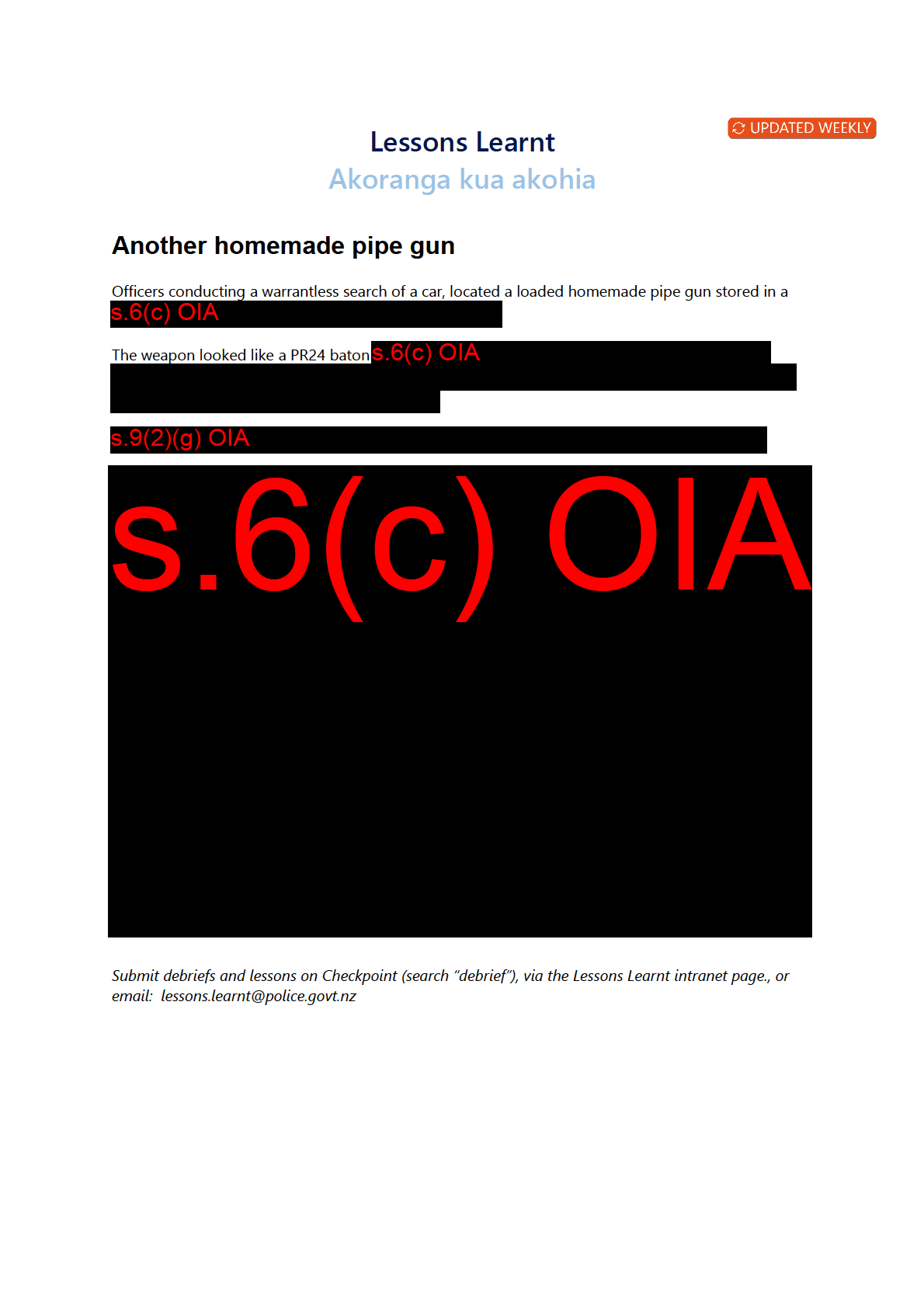


Lessons Learnt - AOS involvement in searches | Ten One - New Zealand Police Intranet Page 1 of 2
Lessons Learnt - AOS involvement in searches
Lessons Learnt - AOS involvement in
searches
28/06/2017
In recent months, there have been a number of occasions where district staff have
undertaken
pre-planned activities or executed search or arrest warrants — known to
involve significant risk — without involving (or even consulting) specialist AOS/STG
personnel. Occasionally, this has also extended to incidents known or believed to
involve firearms/violent armed offenders and repeated patterns of armed or violent
offending.
Even in ostensibly ‘moderate risk’ searches, the recovery of large caches of firearms has
shown how easy it is for planners to under-estimate the safety risks—and suggests it
pays to err on the side of caution.
It isn’t possible to determine a “one-size-fits-all” approach, and it is accepted that every
set of circumstances is different. It is also accepted that those staff dealing directly with
an incident are usually well informed about the likely risks posed by a particular
offender or situation. However, any time that staff deem it necessary to arm themselves
in preparation for a pre-planned event, at the very least they should consult AOS for
advice and to assist their TENR and decision-making.
When undertaking pre-planned high-risk activities, s.9(2)(g) OIA
Those specialist units have the skills,
experience—and additional equipment s.6(c) OIA
—necessary to deal with high-risk situations in the safest way possible.
District AOS commanders are available 24/7 to provide advice and AOS would rather
be involved and not needed than to be needed and not involved.
s.9(2)(g) OIA
but the underlying principle of
TENR is very clear:
“… 'safety is success'. Victim, public and employee safety are
paramount, and every effort must be made to minimise harm and maximise safety”.
https://tenone.police.govt.nz/news/lessons-learnt-aos-involvement-searches
29/08/2017
Lessons Learnt - AOS involvement in searches | Ten One - New Zealand Police Intranet Page 2 of 2
s.9(2)(g) OIA
critical to “maximising safety and minimising risk”
is the need for a thorough pre-search risk assessment and the completion of both the
POL240 risk assessment and the Community Impact Assessment forms and it is
essential that these are sent to Comms and the DCC to enable them to maintain
oversight and ensure
your safety.
s.9(2)(g) OIA
Make sure Comms and the DCC know where you
are and what you’re doing, and if you consider the risk of a pre-planned event is high
enough to justify arming, ask the experts!
Topics:
Frontline
Lessons Learnt
Wellness & safety
District:
National
https://tenone.police.govt.nz/news/lessons-learnt-aos-involvement-searches
29/08/2017
 Lessons Learnt
Akoranga kua akohia
Avoiding “blue-on-blue” fire
Lessons Learnt
Akoranga kua akohia
Avoiding “blue-on-blue” fire
s.6(c) OIA
It is critical that all staff attending incidents consider their potential lines of fire and the possibility of
crossfire; everyone should communicate with each other, and with whoever is controlling the
incident s.6(c) OIA
Never just assume that other staff are aware of your presence—and never just assume where other
staff might be located; communication is key.
Once cordon positions have been assigned to ensure safety, any change in position must be
approved and communicated clearly to ensure continued safety and prevent the possibility of “blue-
on-blue” fire.
Keep your colleagues safe; share your experiences.
Submit your debriefs and lessons here or on Checkpoint, (Search “debrief”).
 Lessons Learnt
Akoranga kua akohia
Complacency and situational awareness
Lessons Learnt
Akoranga kua akohia
Complacency and situational awareness
Previously published items have stressed the importance of appointment retention but there
continue to be occasions when offenders take advantage of momentary complacency or distraction
to try and take appointments from officers.
s.6(d) OIA
It is essential that officers always maintain full situational awareness when on duty—particularly in
relation to safeguarding appointments and dealing with suspects.
s.6(d) OIA
When it is impossible to avoid proximity to offenders, mechanical safety systems are no substitute
for effective situational awareness. Stay safe.
Keep your colleagues safe; share your experiences.
Submit your debriefs and lessons here or on Checkpoint, (Search “debrief”).
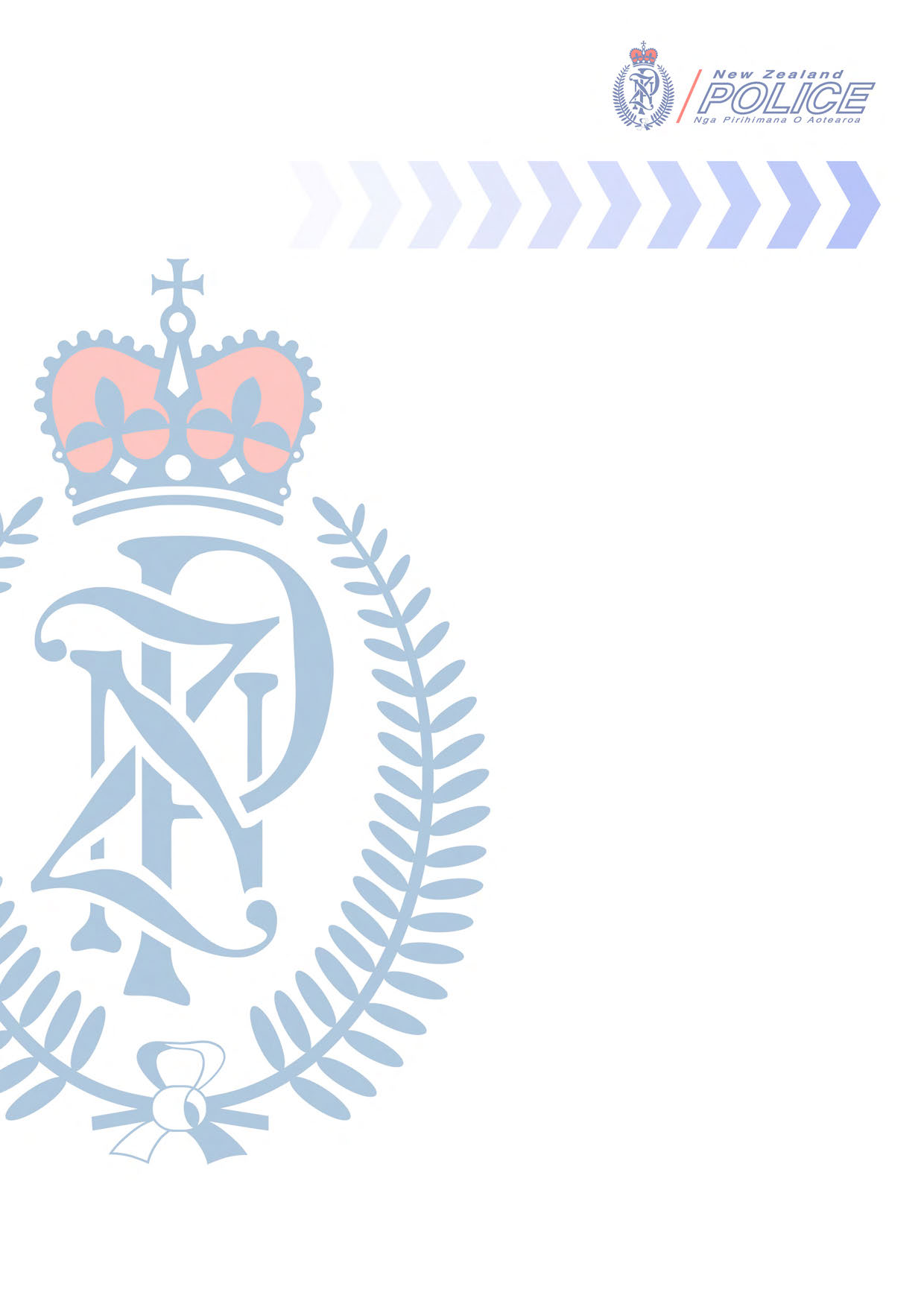 Lessons Learnt
February 2016
• Complaint of excess use of
force and unlawful search
Lessons Learnt
February 2016
• Complaint of excess use of
force and unlawful search
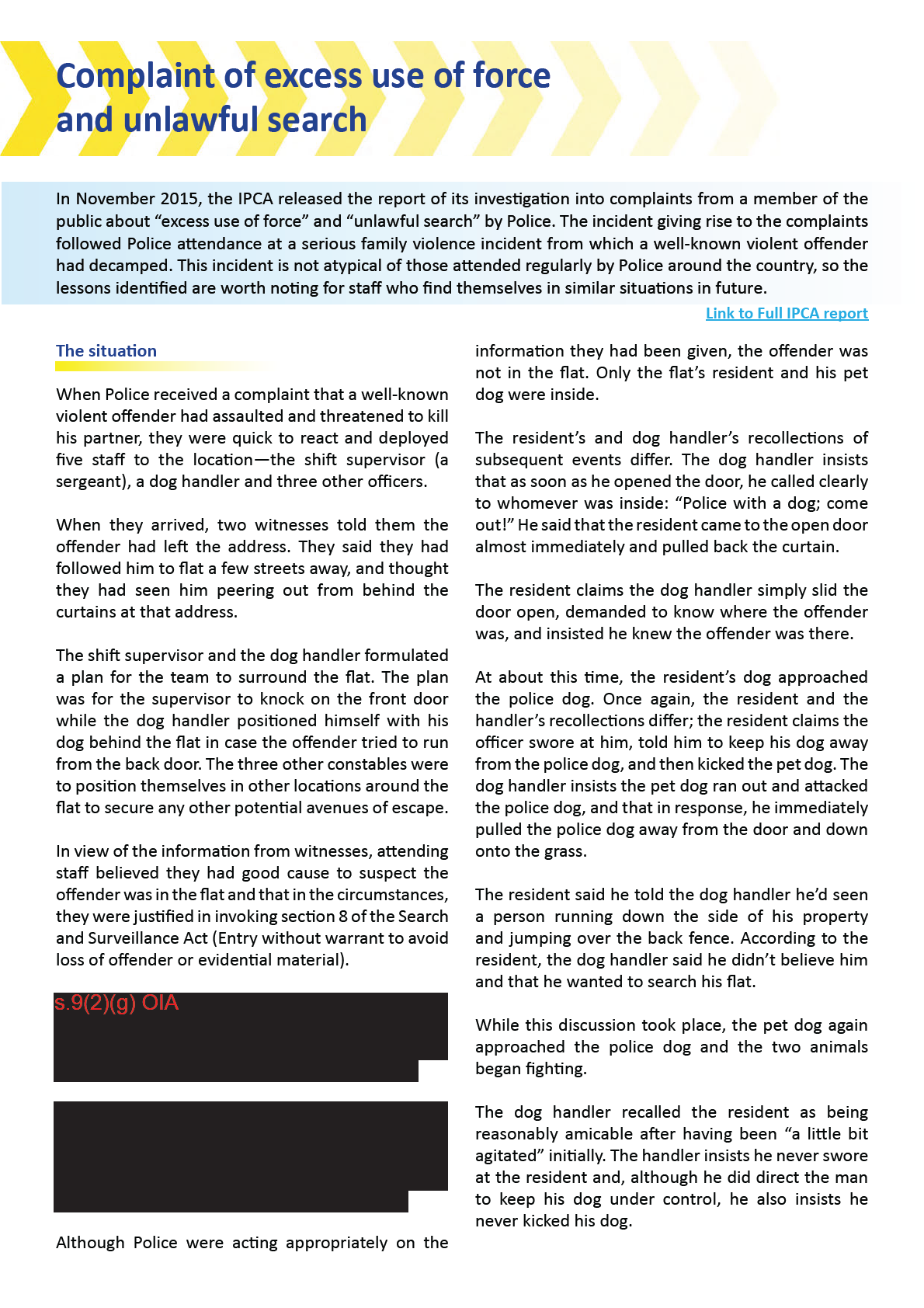
The pet dog subsequently attempted to approach his view that Police hadn’t accepted they had done
the police dog again, at which point another of the anything wrong during this incident.
officers used OC spray on the dog, which immediately
brought it under control. Another officer had a TASER Although one of the resident’s complaints was that
drawn, but did not switch it on or present it.
Police had not paid for his vet’s bill, in fact, the man
didn’t take his dog to the vet and thus there was no
The resident was concerned for his pet’s health after bill to be paid.
it was sprayed but attending officers explained the
necessary after-care rinsing procedure.
The complaint to the IPCA
Once the dogs were under control, the dog handler
told the resident that Police needed to search his flat Not satisfied with the Police’s response to his
under the Search and Surveillance Act. The sergeant complaints, the man complained to the IPCA.
appointed another of the officers to oversee the
search and that officer also told the resident he The IPCA subsequently considered there were
four
needed to search his house under the Search and issues to be investigated:
Surveillance Act. He told the resident they were
looking for an offender who had allegedly assaulted 1. Was it appropriate for the dog handler to make
his partner.
the first approach to the flat with his dog and
enter the flat?
The officer overseeing the search says the resident
consented to the search and held onto the pet dog 2. Were the dog handler’s demeanour and attitude
while the officers searched the flat.
unprofessional and aggressive?
3. Did Police have legal justification to enter the flat
The complaint to Police
to search for the offender?
The next day, the resident complained to the Police, 4. Was the use of OC spray on the resident’s dog
listing six points of concern:
justified in the circumstances?
1. The Police dog handler had opened his door
without announcement.
The IPCA’s findings
2. The dog handler had sworn at him and kicked his 1. While the Authority found the dog handler
pet dog.
was justified in taking his dog with him, they
considered that in view of the agreed plan to
3. Police had searched his house despite being told
cordon and contain the property, he should not
the man they were after was not present.
have made a unilateral decision to open the door.
4. There was no need to use OC spray on his pet 2. Because of the conflict between the resident
dog.
and the dog handler’s versions of events, the
Authority was unable to make a finding as to the
5. Police should have paid his vet’s bill.
dog handler’s demeanour or attitude.
6. Police should have apologised for their actions 3. In terms of their authority to search the
during the search.
resident’s flat, attending officers justified the
search firstly, on the basis that it was consensual
Police acknowledged that the resident was an
(section 92 off the Search and Surveillance Act),
innocent party and attempted to resolve his
and, secondly, they believed they had the power
complaint, with three different senior officers
to search under section 8 of the Act.
apologising to him over the course of the next two
months.
Unfortunately, although finding a section 8
search was justified, the fact that dog handler
The resident didn’t accept the apologies because of
had not identified himself by name or number,
as required by section 131 when invoking this to deploy several staff to deal with a known violent
power, made the actual search unlawful.
offender reflected the potential threat to both
staff and victims. Similarly, the decision to deploy
Furthermore, although the officers might a dog-handler and dog reflected the high degree
otherwise have been able to conduct a (section of “deterrence” provided by dogs against violent
92) consensual search, because they did not
offenders. At least one member also elected to carry
advise the resident—as required by section 93—
a TASER (before TASERs were routinely carried),
that he could refuse permission for a search, the
which reflected appropriate recognition of the
search was also unlawful in terms of section 92.
perceived threat from a known offender.
The IPCA made specific note of the need to The original plan formulated by the shift supervisor
balance the power to intrude into people’s and the dog handler reflected their appreciation
private spaces with the responsibility to fully of potential threat and, had the plan been carried
inform them of their rights when doing so.
out as intended, would have mitigated exposure as
much as possible.
4. As far as the use of OC spray on the resident’s
dog, the IPCA accepted that its use was both
Dog handlers are routinely the first on scene at
appropriate and justified. The authority was
critical incidents and, except for their dogs, must
satisfied that the dog handler had given the
often confront violent and frightening situations
resident plenty of opportunity to control his dog,
alone. The nature of their role therefore requires
and it had already fought with the police dog
them to think on their feet and be prepared to react
more than once before it was sprayed.
quickly to changing situations.
However, this incident reinforces the need for both
Summary
dog handlers and other staff working closely with
them, not only to continuously update their TENR,
There was no suggestion that any of the attending but also to communicate effectively.
officers acted unreasonably or used excessive force.
However, the Authority considered that in view of
the number of officers present and an agreed plan
Search and Surveillance Act awareness
of action to cordon and contain, the dog handler’s
decision to enter without knocking was not good This incident highlights the need for complete
practice and potentially placed other officers at risk.
familiarity with the provisions of the Search and
Surveillance Act.
The Authority’s view was that in situations such
as this, Police could reasonably expect there to The
technicalities
of
legislation—however
be innocent people or unsecured pets inside an burdensome they might seem—must be adhered
unknown address. (In this incident, it noted the pet to strictly if Police are to maintain the highest
dog’s response was “probably a predictable result of public trust and confidence, especially when
the surprise intrusion onto its property”.) In view of that legislation relates to intrusions onto private
the number of officers present on this occasion, the property or otherwise adversely impacts the rights
Authority considered another officer should have of individuals.
made an initial door-knock at the address (as per the
agreed plan) and that the dog handler should have There is no suggestion that Police abused their
provided back-up further away from the door.
powers deliberately on this occasion but by
overlooking simple legislative requirements, their
search, which—while completely justified—became
Lessons identified
“unlawful”.
TENR
Despite the issues identified in the IPCA report, many
Link to Full IPCA report
aspects of this incident demonstrate appropriate
TENR thinking by the staff involved. The decision
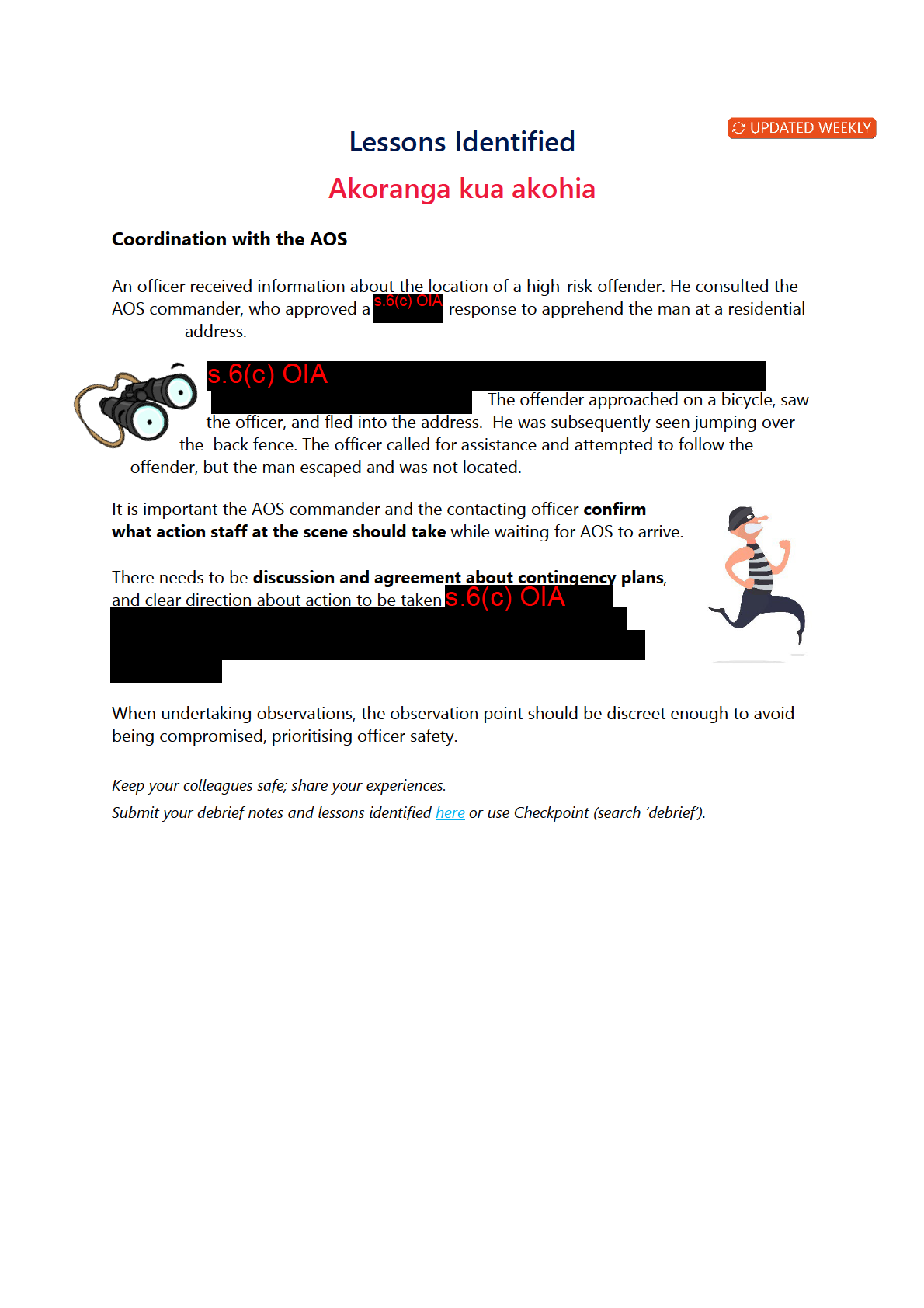
 Lessons Learnt
Akoranga kua akohia
Disclosure of personal details
Lessons Learnt
Akoranga kua akohia
Disclosure of personal details
Think careful y before disclosing someone’s sensitive personal details or circumstances
with others who don’t need to know. However well-meaning your intentions, this has
potential to cause significant emotional harm, and damage trust in Police.
s.9(2)(a) OIA
Privacy Survey 2023
New Zealand Police Assurance Group is seeking feedback from staff about their understanding and
experience of the Privacy Act and the value of personal information to their work.
Your responses wil be combined with others - you will not be identified in any reported survey
results.
https://www.surveymonkey.com/r/FQLWP6L
If you have any queries or concerns about the survey, please email
[email address], [email address] or [email address]
Keep your colleagues safe; share your experiences.
Submit your debrief notes and lessons identified here or use Checkpoint (search ‘debrief’).
 Lessons Learnt —February 2017
DOGS
Lessons Learnt —February 2017
DOGS
Dog units are commonly among the first responders to attend the most difficult
and dangerous critical incidents. As a result, dog handlers are widely recognised
for their tactical capability, leadership and decision-making.
However, when the Comms dispatcher tells you that s.9(2)(g) OIA to your job,
you must understand that dogs are not invincible and, like every other tactical
option, there are some limitations to the kinds of tasks they can realistically and
safely perform.
A number of incidents in recent months have highlighted some concerns and
identified a number of lessons around the deployment and capabilities of police
dogs, and occasional inflated expectations of them by other staff and the public.
s.9(2)(g) OIA dogs all have unique personalities, temperaments and different
strengths and weaknesses; some dogs are excellent trackers while others
excel at controlling violent offenders. A significant factor is their operational
experience. s.9(2)(g) OIA
dogs will grow in confidence, skill and ability the
more operational experience they have. Handlers know their dogs best and their
familiarity with their dogs will determine whether or not they should be deployed
in the circumstances on a given day.
While dogs are “tactical options”, they are not “equipment” in the same way as
OC spray, TASER or firearms and cannot be expected to operate in a exactly the
same way that a switch or a trigger activates a TASER, OC spray or firearms.
There is a great deal of reliance on handlers’ experience of their dogs and an
unavoidable degree of subjectivity in any decision to deploy dogs as tactical
options.
The decision as to whether a dog should be deployed against an armed offender
or to protect you or anyone else, depends on all the circumstances s.9(2)(g) OIA
Among the range of factors that influence dog handlers’ decisions as to how,
when and why to deploy their dogs are such thing as:
• the nature and seriousness of the offending, s.6(c) OIA
• the use (and type) of weapons and an s.6(c) OIA
to use them
• the training certification, and operational experience and capability of the
dog
• exposure of other people (Police and public) to avoidable risk
s.6(c) OIA
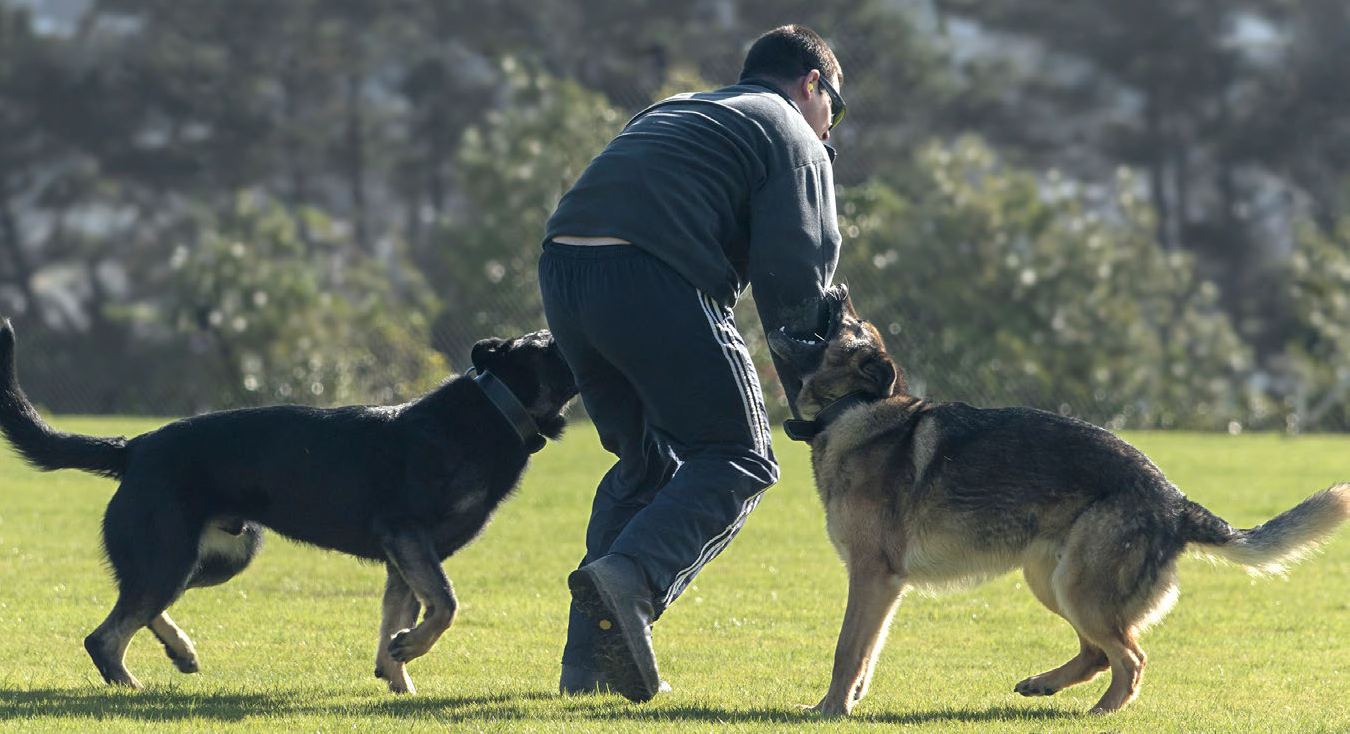

s.6(c) OIA
Dogs’ abilities to outrun any human and use their incredible noses to locate
target individuals in circumstances where no human could find them is
exceptional. s.6(c) OIA
Make sure your TENR thinking and PCA takes these
things into account; dog handlers consider all these
things and more and are constantly reassessing
TENR and their PCA in every situation.
s.9(2)(g) OIA
Dog handlers are more than happy to discuss with you the dogs’ capabilities in
various circumstances and are happy to attend training days to increase your
knowledge around the role of a dog team.
Feel free to provide feedback on any of the articles you read in lessons learnt.
Click on the following link to email Lessons Learnt:
[email address]
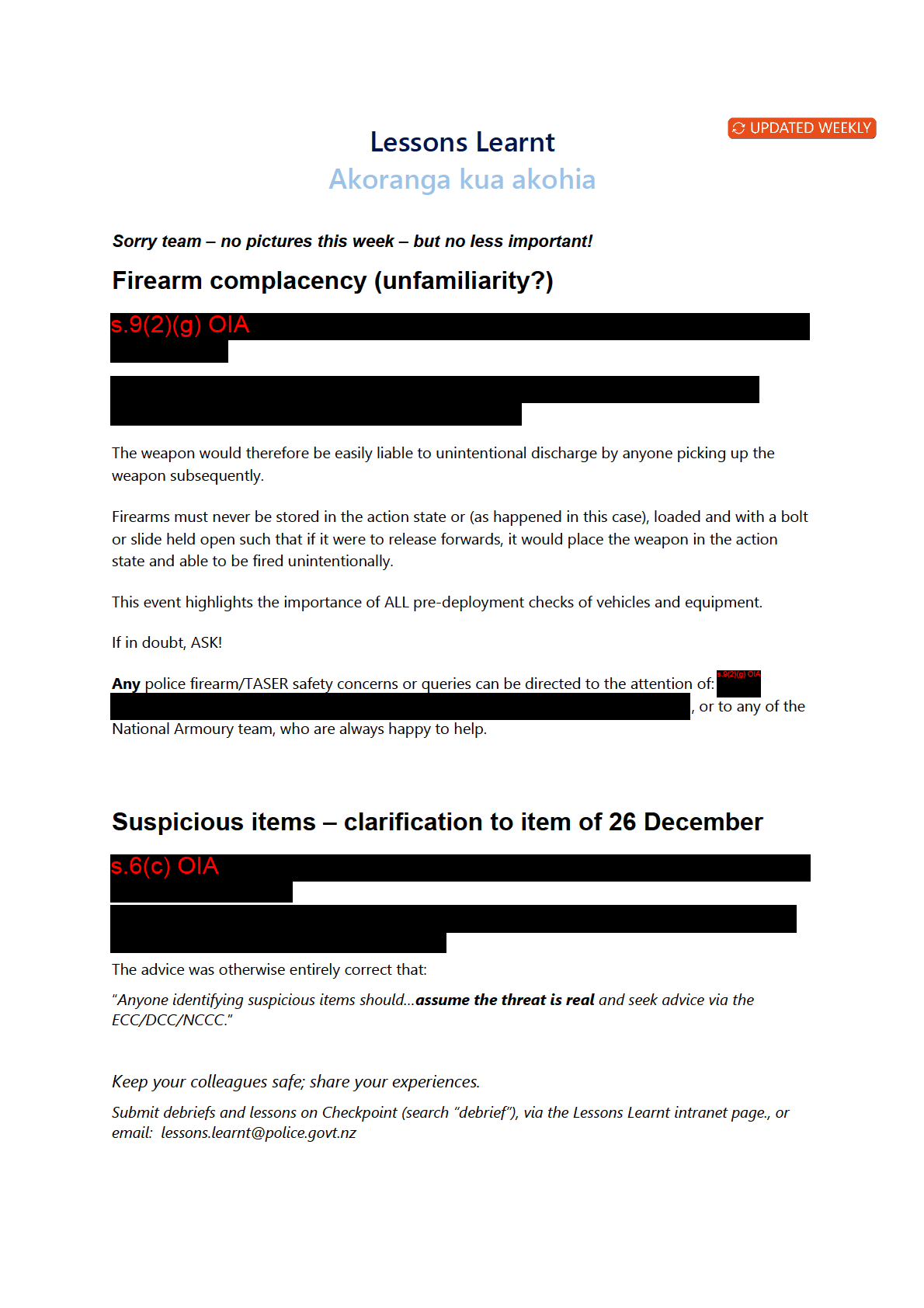
 Lessons Learnt
Akoranga kua akohia
Firearms Seizures
Lessons Learnt
Akoranga kua akohia
Firearms Seizures When seizing firearms, ensure relevant information is recorded in;
1. NIA - required by the national recording standard
2. Prop - if seized as an exhibit
3. RIOD – in the daily occurrence log via the DCC
4. Gun Safe – RIOD Firearms Event Log - Lessons Learnt: Use of RIOD Firearms Event Log (GunSafe)
5. s.6(c) OIA
Data Quality
The data we col ect, and record informs (among other things);
• Victim focused service delivery
• Intelligence picture
• Deployment
• Business cases for resources
• Official statistics
• Measures of police performance
Support the Data Quality and Integrity team by taking the time to accurately record offence data and
resolutions.
To learn more about the importance and impact of data quality, check out the Data Quality and
Integrity team resources pages.
s.6(c) OIA
Keep your colleagues safe; share your experiences.
Submit debriefs and lessons here or on Checkpoint (search “debrief”).
 Lessons Learnt
Akoranga kua akohia
Lessons Learnt
Akoranga kua akohia
Firearms Seizures When seizing firearms, ensure information is recorded in the relevant databases.
Officer who seized the firearm:
1. Record details of the firearm into -
Firearms Search and Seizure (FSS) notifications database
– this fulfils the legal requirement (s169(1) of the Search and Surveillance Act 2012) to notify
the commissioner of any search under the Act. The FSS allows for recording of searches in
relation to s6 and s18 of the Act and whether any firearms/explosives/ammunition were
seized. Note -
If the seizure occurred within an AOS deployment, completing the seizure
section of the AOS Deployment Report wil send these details to FSS automatically.
2. If the firearm is brought to a Police station, record details of the firearm into
Police Register
of Property (PROP).
3. Record details of the offence or incident that led to the seizure of the firearm into -
NIA as
an Occurrence.
District Command Centres:
1.
RIOD – in the daily occurrence log via the DCC.
2.
Gun Safe – RIOD Firearms Event Log - Lessons Learnt: Use of RIOD Firearms Event Log
(GunSafe)
Keep your colleagues safe; share your experiences.
Submit debriefs and lessons here or on Checkpoint (search “debrief”).
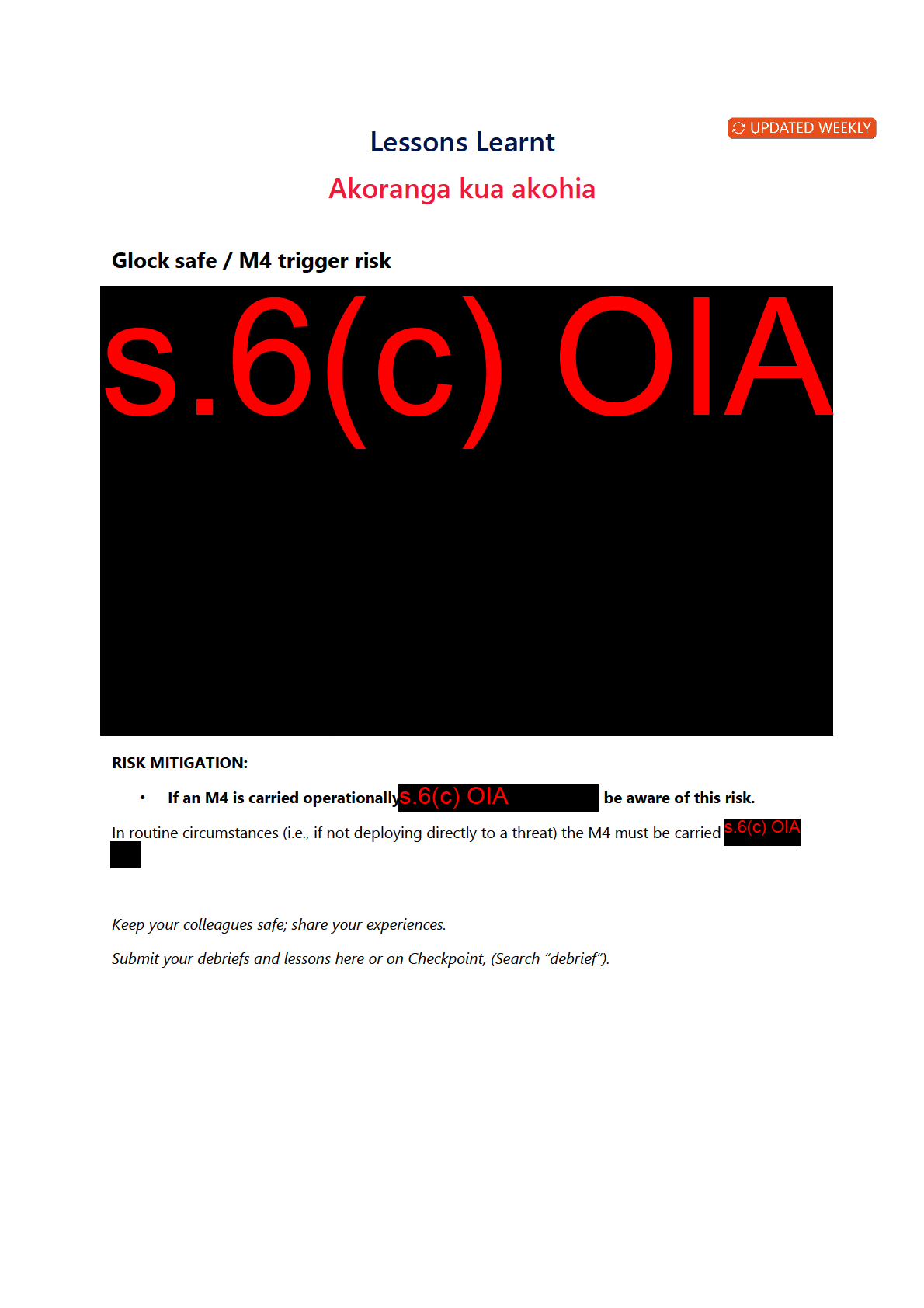
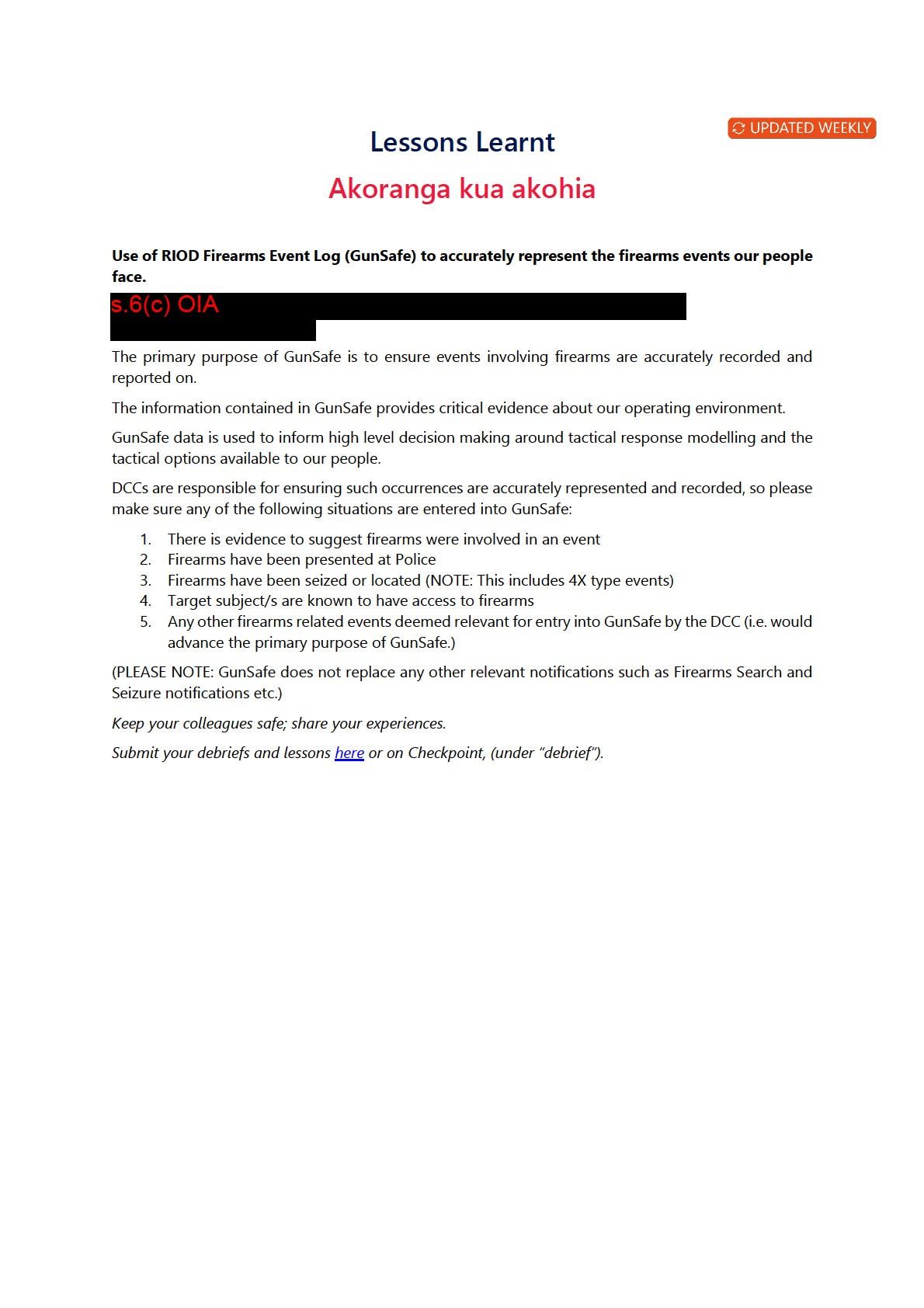
 Lessons Learnt
Akoranga kua akohia
Homemade firearm – modified paintbal gun
Situation
Lessons Learnt
Akoranga kua akohia
Homemade firearm – modified paintbal gun
Situation
s.9(2)(g) OIA District staff executed a search warrant at a private address. Inside a wardrobe, they
located the homemade firearm pictured here.
s.6(c) OIA
The weapon had to be inverted to extract a spent casing before another round could be loaded.
Lessons identified
s.9(2)(g) OIA
s.9(2)(g) OIA
Be on the lookout for similar modified paintball guns or other “toys”.
Keep your colleagues safe; share your experiences.
Submit your debriefs and lessons here or on Checkpoint, (Search “debrief”).
 Lessons Learnt
Akoranga kua akohia
Homemade firearm seized
Lessons Learnt
Akoranga kua akohia
Homemade firearm seized
Officers making enquiries into a 1C / burglary event, subsequently located a patched gang member.
When he saw police, he attempted to hide an object that officers found to be a homemade 'pipe gun'.
s.6(c) OIA
While simple in design, the weapon would easily be lethal at close range.
s.6(c) OIA
Be vigilant—always. No event is ‘routine’, and no job is ‘simple’.
s.6(c) OIA
Keep your colleagues safe; share your experiences.
Submit your debriefs and lessons here or on Checkpoint, (Search “debrief”).
 Lessons Learnt
Akoranga kua akohia
Human Source Confidentiality
Lessons Learnt
Akoranga kua akohia
Human Source Confidentiality
s.9(2)(g) OIA
Members of the public, s.6(c) OIA
, provide information to Police in the
expectation it will be kept confidential.
For example, if describing a conversation with an s.6(c) OIAin which they identify an offender, we
must NOT write in such a way that thes.6(c) OIA could be identified; we would NOT say,
s.9(2)(g) OIA
Instead, we would say something like,
“Information from the public has identified the two offenders,
and the CIB is investigating.”
Think carefully about the privacy of every person you write about, regardless of whether a document
is only intended for internal publication. It is too easy for unrestricted documents to be shared and
breach people’s privacy or jeopardise their safety.
See the Police Manual for instructions on Police Human Sources
https://tenone.police.govt.nz/pi/part-1-introduction-police-human-sources
There is an onus on al of us to educate col eagues. If you sight a document that could s.6(c) OIA
, take some action or seek advice.
Keep your colleagues safe; share your experiences.
Submit your debriefs and lessons here or on Checkpoint, (Search “debrief”).
 Lessons Learnt
Akoranga kua akohia
Lessons Learnt
Akoranga kua akohia
Importance of thorough search when clearing an address Staff attended a family harm event where a male offender
on electronic bail had cut off his EM bail bracelet, and
s.6(c) OIA
had several warrants to arrest. He was also flagged for
firearms.
Officers cordoned and then 'cleared' the address, but did
not locate him. The woman at the house told officers he
had left.
When a dog unit was unable to find a track away from the
house, and officers advised the woman the dog would
search inside the house, she became obstructive. She
sprayed perfume around the house and assaulted one of
the officers.
s.6(c) OIA
Of enders are skil ed at creating new and innovative
hiding places for themselves, weapons, drugs and other
contraband.
s.9(2)(g) OIA
Consider locations such as s.6(c) OIA
Keep your colleagues safe; share your experiences.
Submit debriefs and lessons here or on Checkpoint (search
“debrief”).
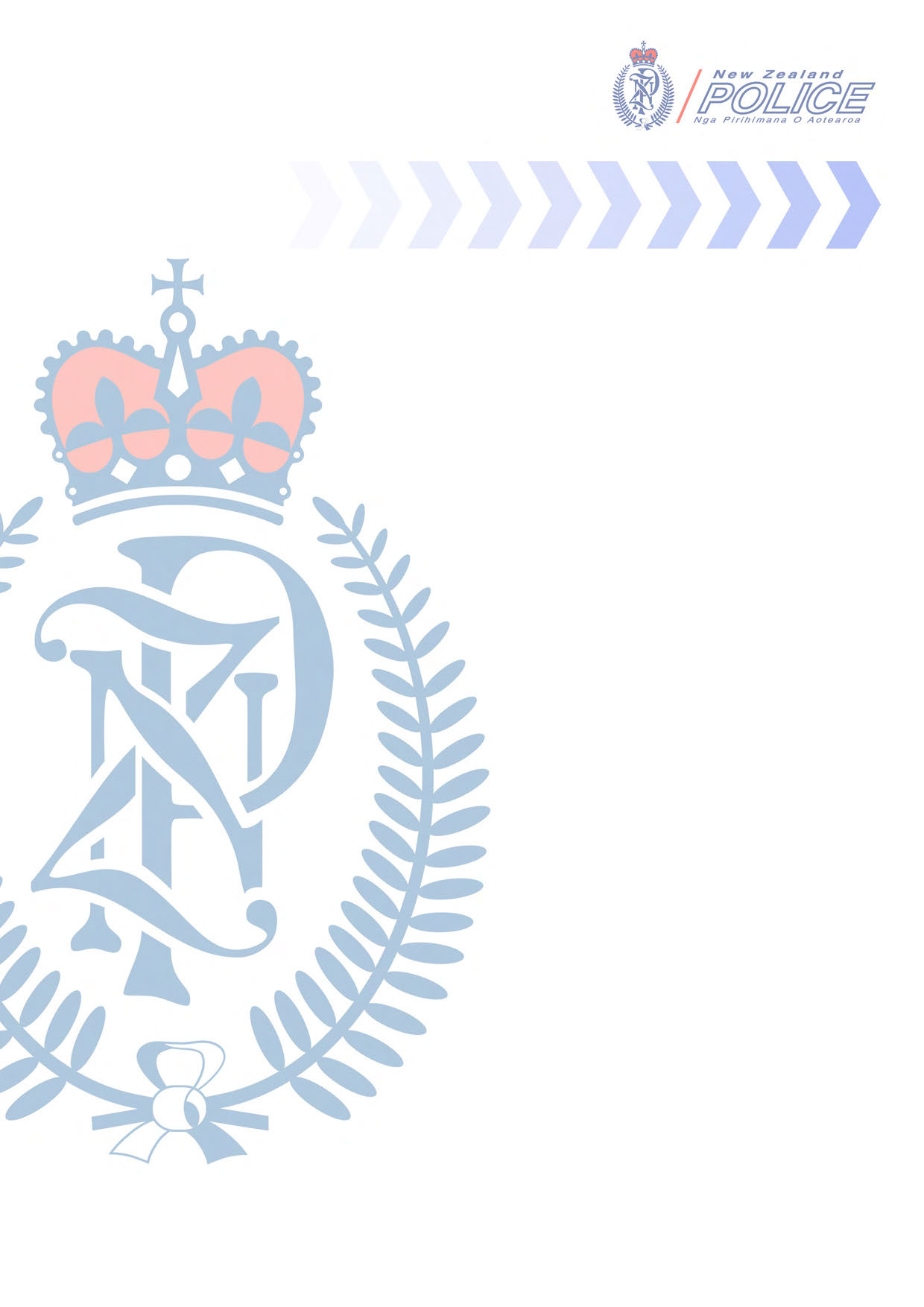 Lessons Learnt
April 2016
• Inadequate Service / Failure to
Investigate
Lessons Learnt
April 2016
• Inadequate Service / Failure to
Investigate
The importance of communication and
empathy to increasing trust and confidence
• Cunning Concealment Countered
Successful search when executing warrant
highlights the importance of thorough
searching and thinking “outside the square”
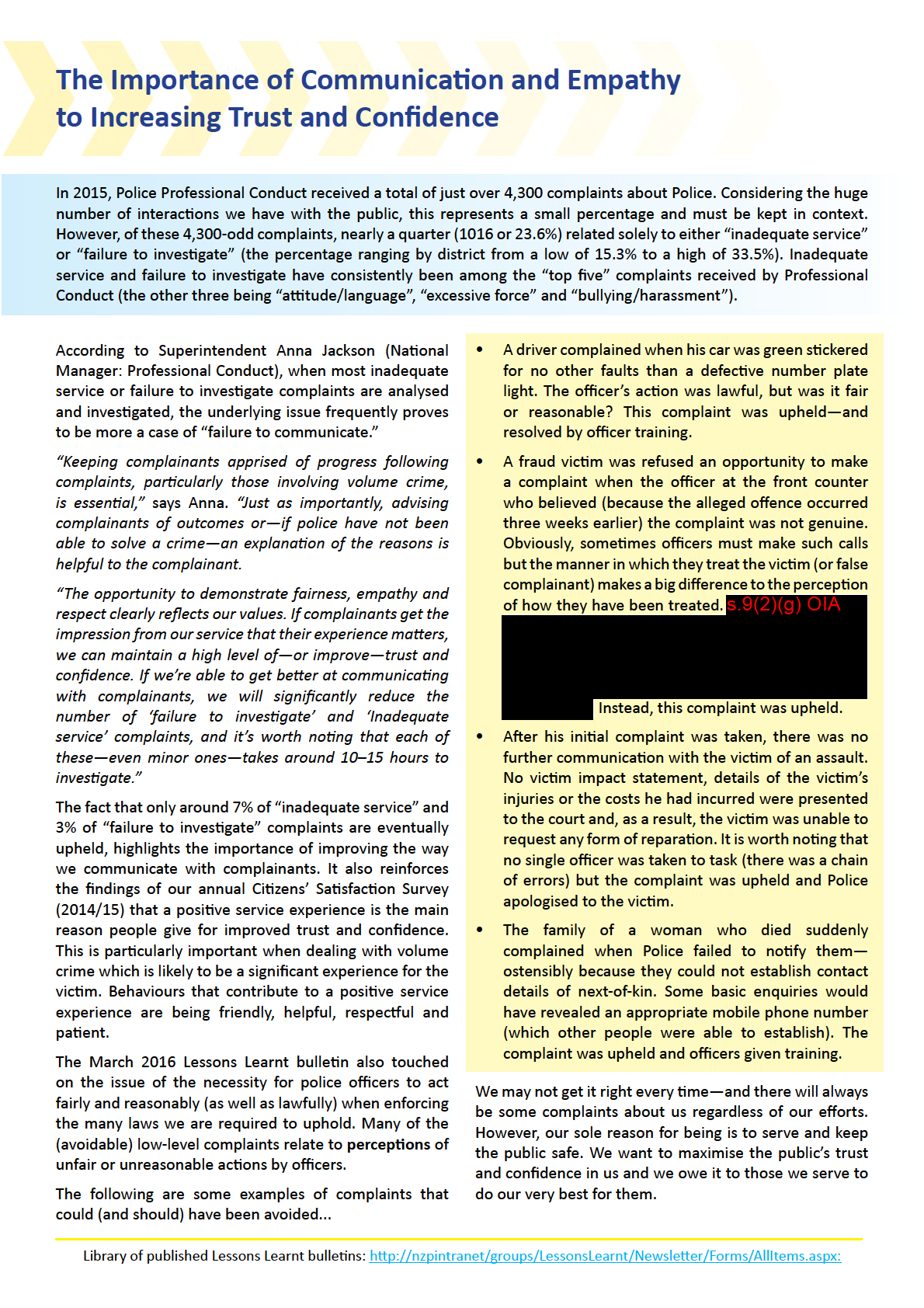

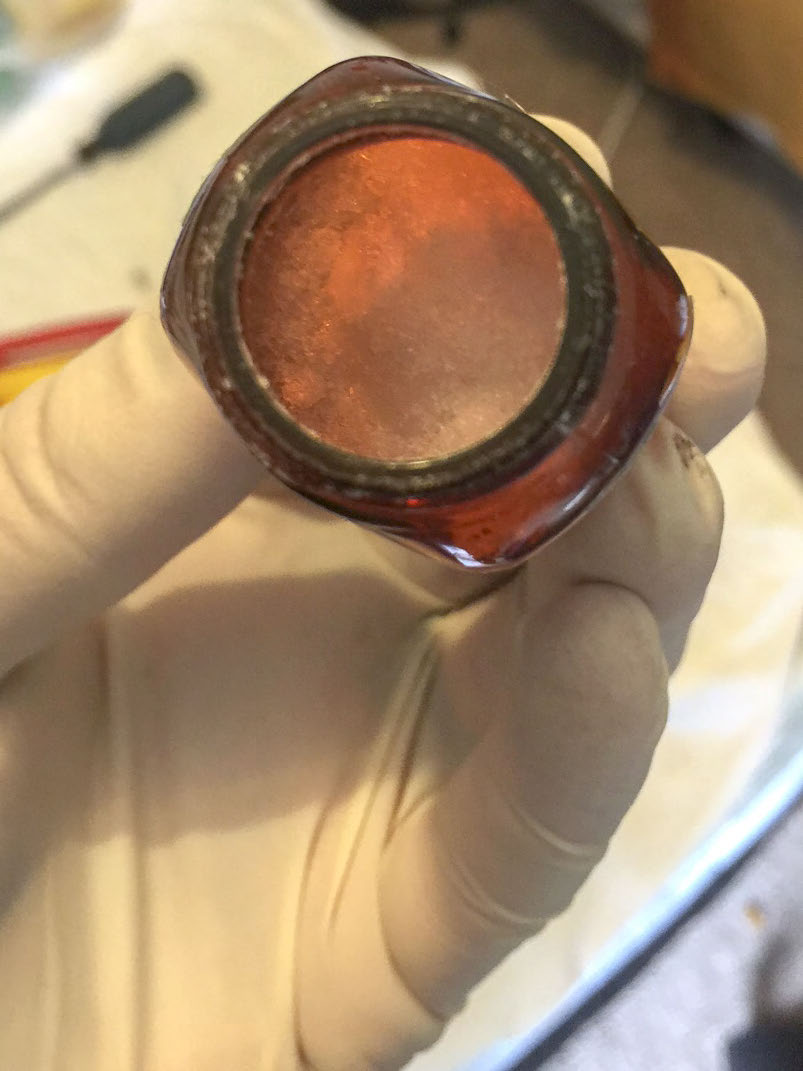
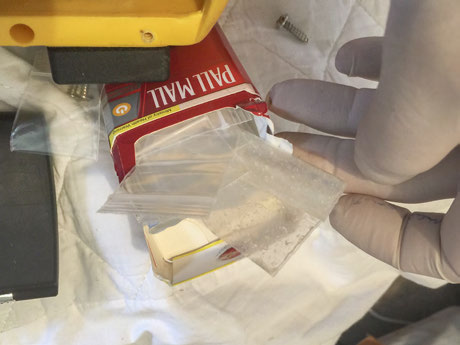
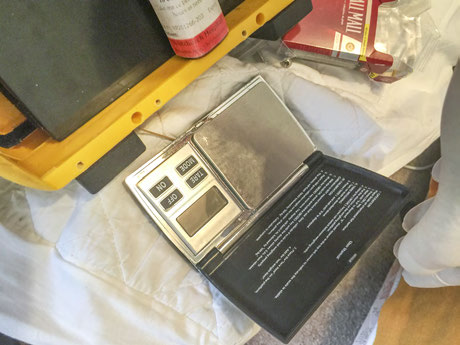 Cunning Concealment Countered
Cunning Concealment Countered
s.6(c) OIA
s.6(c) OIA
The find highlights the importance of
thinking “outside the square” when
searching for drugs or other contraband,
which offenders are continually finding
new and unusual ways to conceal.
Well done to those involved.
Above: Cigarette packet contained a number of plastic deal
bags.
Above: Fifteen grams of methamphetamine that didn’t make it onto the
Above: A lightweight folding scale completed the “kit”.
street.
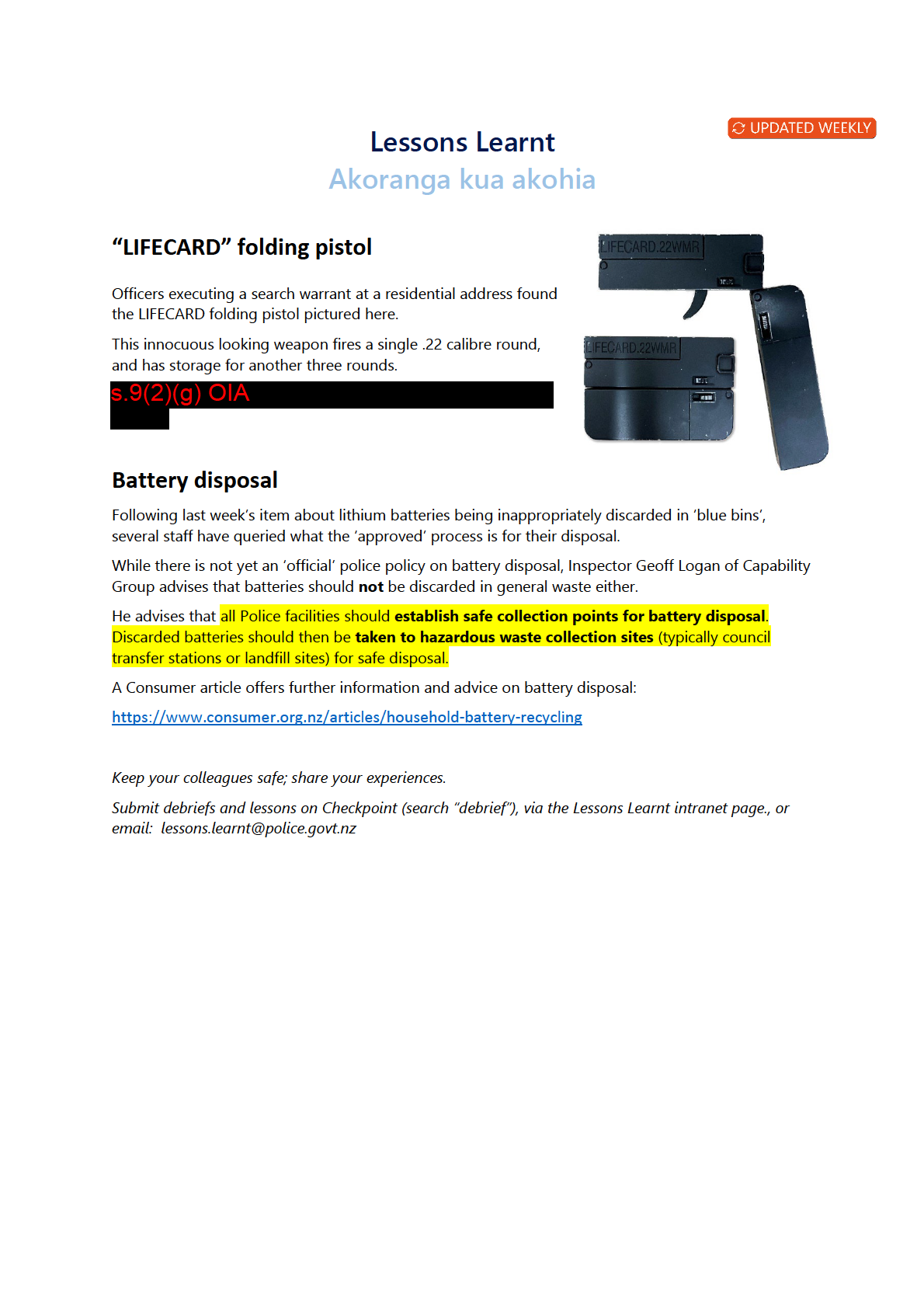
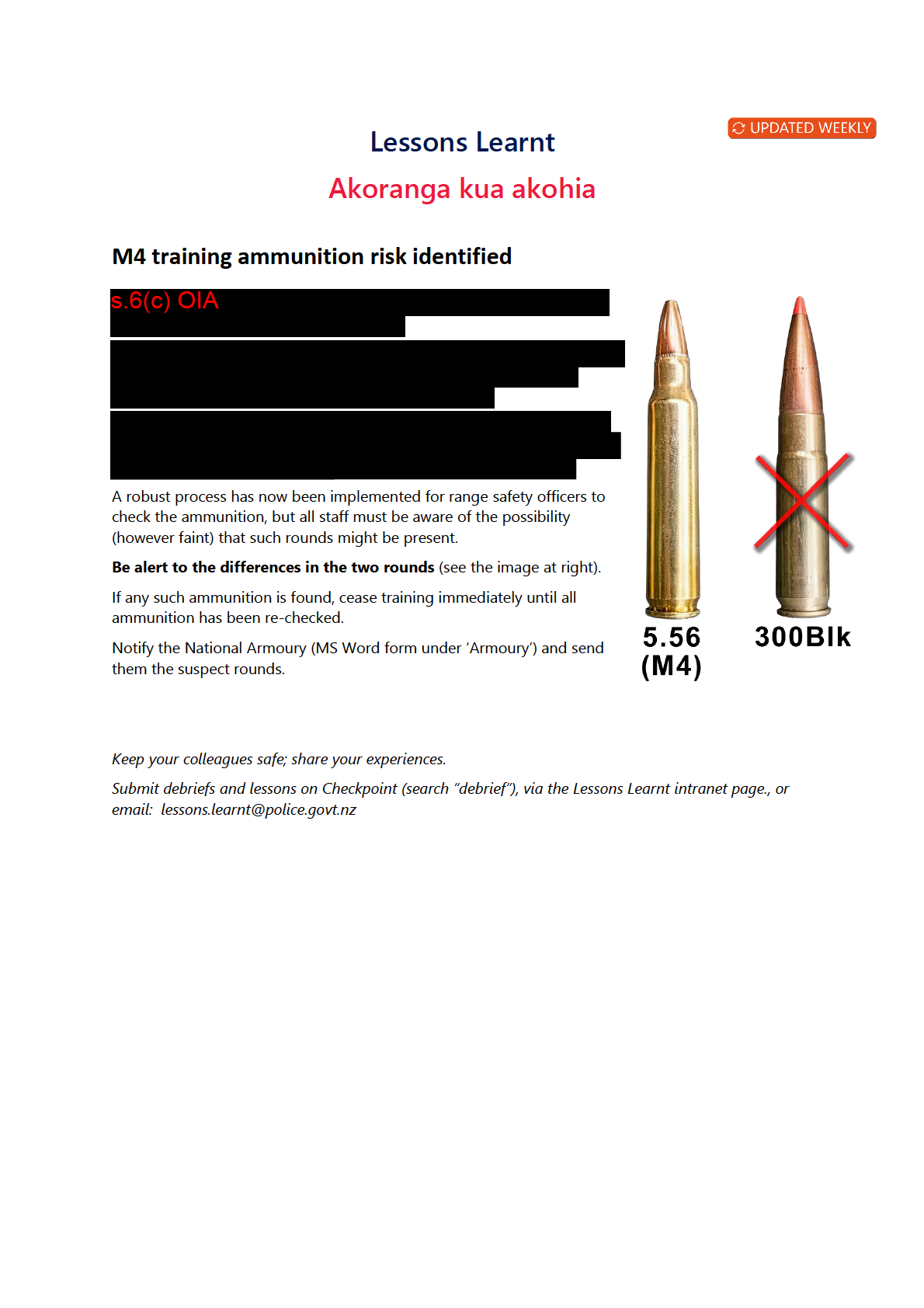

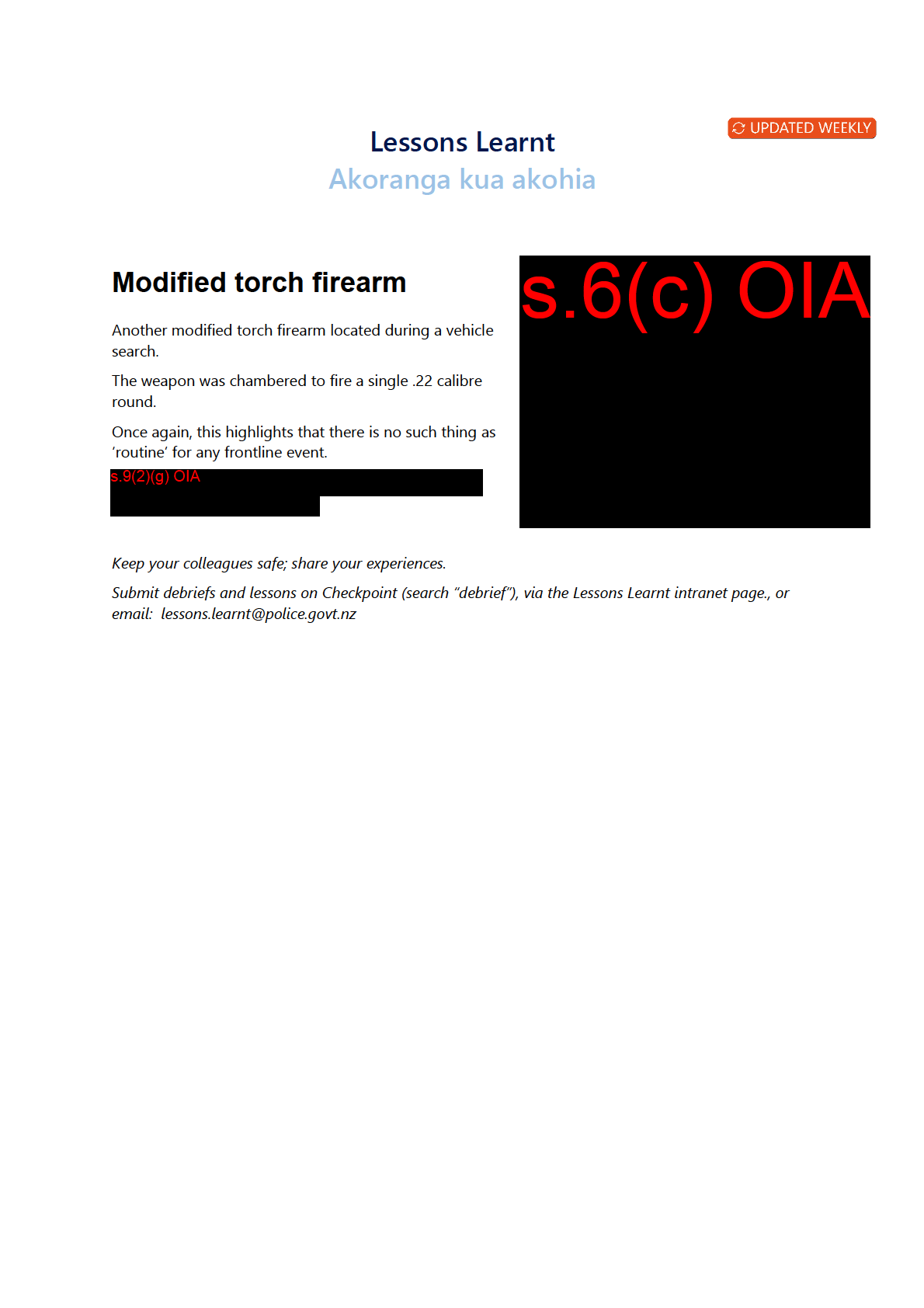

• In this case the Search and Surveillance Act 2012 (SSA) was also invoked during the inventory
process, upon the finding of what was believed to be methamphetamine. The District Court and
the Court of Appeal also found this to have been lawful y invoked in these circumstances.
Keep your colleagues safe; share your experiences
Submit your debriefs and lessons here or on Checkpoint.


Redaction/Disclosure Error | Ten One - New Zealand Police Intranet
Page 1 of 2
Redaction/Disclosure Error
Lessons Learnt - Redaction/Disclosure
Error
19/06/2017
Situation
The lawyer acting for a defendant in a serious assault case applied to have the case
against his client dismissed after the O/C—who was out of district and unavailable at
the time the matter first went to court—failed to provide disclosure as required.
s.9(2)(g) OIA
The prosecutor identified s.9(2)(g) believed should be redacted prior to disclosure. s.
, he attempted to redact the information using a black pen. However, the
9(
2)
redaction was ineffective and private/sensitive information could still be ascertained
beneath the “redaction”.
When the lawyer notified Police and the Crown Law Office of the inadvertent inclusion
of private informations.9( gave an assurance thats.9 had not passed the information on
to the defendant. However, it can never be guaranteed that information that has been
disclosed electronically cannot be retrieved or accessed in future.
Lesson identified
Inadvertent disclosure of sensitive information or private details threatens the privacy
and security of those whose information is shared inappropriately. As a result, it also
presents a significant risk to trust and confidence in Police.
It is essential that—particularly when disclosing or sharing information
electronically—staff
take extra care to ensure only the correct information is
disclosed/shared and that no sensitive or private information is included.
Ensure that any redaction necessary is undertaken using the redaction function in
Adobe Acrobat Pro (the minimum approved software is Adobe Acrobat Pro 9 or later).
The use of pen/felt pen or other forms of redaction is unacceptable.
The Police Instructions chapter on Electronic redaction and disclosure covers all
https://tenone.police.govt.nz/news/redactiondisclosure-error
29/08/2017
Redaction/Disclosure Error | Ten One - New Zealand Police Intranet
Page 2 of 2
aspects of redaction, including instructions on how to effect this using Acrobat Pro.
The Electronic redaction and disclosure policy also dictates that
“Supervisors must
ensure electronic disclosure complies with these instructions to prevent compromising
the confidentiality of information.”
Comment
In this case, an investigation accepted that the prosecutor was acting with the best of
intentions for the right reasons and, following a professional conversation, s.9(2)(g) OIA
training in redaction and the use of Adobe Acrobat Pro. However, the disclosure of
sensitive/private information is an extremely serious issue, as Police policy makes
clear:
“Any disclosure that does not comply with policy and jeopardises an
individual's personal safety and privacy, will be referred for employment
investigation and may amount to serious misconduct.”
Check twice (or more), click once!
Topics:
Legal/Prosecution
Lessons Learnt
Police Instructions
Security & privacy
District:
National
https://tenone.police.govt.nz/news/redactiondisclosure-error
29/08/2017

 Lessons Learnt
Akoranga kua akohia
Situational awareness – radio eavesdropping
Lessons Learnt
Akoranga kua akohia
Situational awareness – radio eavesdropping
A lone officer conducted a 3T in a remote area where there was no cell phone coverage.
Because s.9was unable to obtain checks on s.9 mobility device, the officer queried the driver by
radio. (2)
(2)
s.6(c) OIA
Fortunately, the officer was able to disable the car and free
a
s.9(2)(g) nd subsequently arrested the offender.
OIA
For your safety, and the security of sensitive information, s.6(c) OIA
Keep your colleagues safe; share your experiences.
Submit debriefs and lessons on Checkpoint (search “debrief”), via the Lessons Learnt intranet page., or
email: [email address]
 Lessons Learnt
Akoranga kua akohia
Lessons Learnt
Akoranga kua akohia
Skoda window opening/closing
Several staff have returned to their locked Skoda patrol cars to discover all four windows
wound all the way down.
The Skoda key fob can be set to wind all of the windows down by continuously pressing the
‘unlock’ button, and wind them all up by continuously pressing the ‘lock’ button.
This functionality can be changed in the central touch-screen display.
From the home screen, choose the ‘
Vehicle’ menu.
Then go to ‘
Settings’
Scroll up to ‘
Opening and closing’
Under ‘
Window operation’ is a sub menu for ‘
Convenience opening’.
This allows the user to choose ‘
All windows’, ‘
Driver window’, or ‘
Off’.
To avoid the possibility of inadvertently opening all of the windows (such as has happened
with the key fob squashed in a pocket), select ‘
Off’
A video at this link demonstrates the process for changing the window settings.
s.9(2)(g) OIA
Keep your colleagues safe; share your experiences.
Submit debriefs and lessons here or on Checkpoint (search “debrief”).
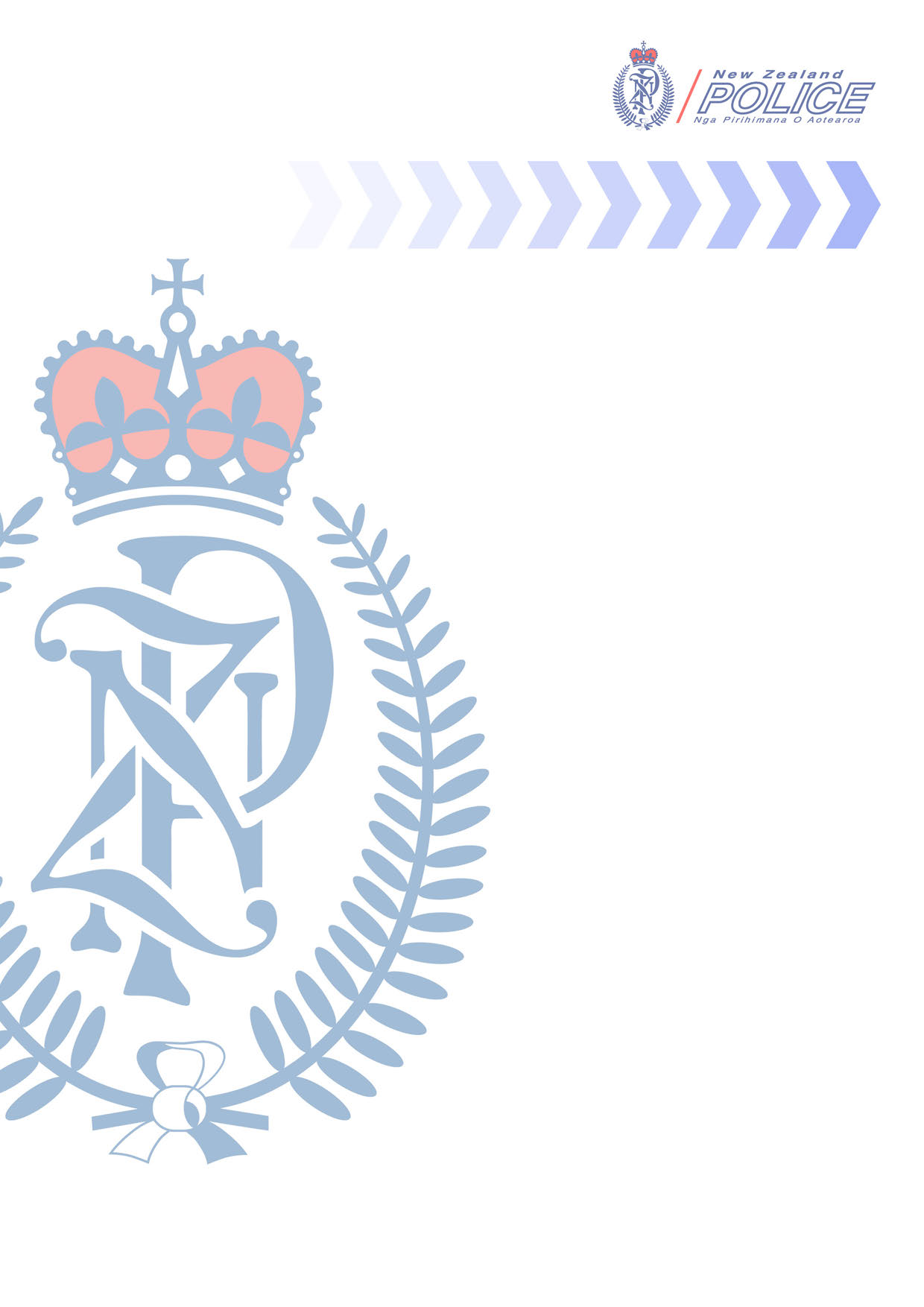 Lessons Learnt
October 2015
Lessons Learnt
October 2015


with four officers present at the property—armed available in unlimited quantities to independent
with a range of tactical options, including OC spray reviewers and the media), they did not need to
and TASER—it is unlikely that the officers were respond in the manner they did…and a range of
“exposed” to any significant degree of threat in the unsatisfactory consequences resulted.
circumstances. The woman’s manner suggested
that she had no fear for her safety, and did not
Inaccurate evidence:
feel threatened and she made it clear that she,
too, wanted the officers to leave. However, as the The most significant of the “flow-on” consequences
situation began to escalate (between the officers, Mr related to the differences between the TASER
Reuben and the woman), the children in the house camera footage from the event and the two officers’
became increasingly exposed to both physical harm notebook entries. It is not unusual for officers’
and emotional distress.
recollections of events to differ from video or audio
recordings; all humans are naturally fallible and
Had the officers been continuously re-assessing their prone to perceive and recall events differently—
TENR, it is likely they would have felt less “necessity” especially in times of stress. Unfortunately, technical
to act immediately and perhaps it would have been issues meant that the TASER camera footage was
better had their “response” been to withdraw not available for viewing until after a court date had
(even if only temporarily to allow Mr Reuben and been set for a defended hearing and the officers
the woman to leave the shower and dress), and had already written their briefs of evidence, which
communicate this course of action calmly to them.
differed from what was evident in the TASER footage.
The IPCA report describes events in a way which The officers did not amend their briefs of evidence
suggests both the officers and the adults were talking to take account of what the TASER camera disclosed,
“at” each other without actually “listening” or trying but persevered in giving evidence in court in
to understand the other (i.e. failing to “communicate”
accordance with their original briefs.
effectively). The Authority also noted the officers’
failure to separate Mr Reuben and the woman and Police (both the officers and Prosecutions) were
communicate with them individually.
aware that the evidence given did not match the
TASER footage, but it was decided (incorrectly) that
It is to be expected that agitated subjects might it would be acceptable to explain the discrepancies
be unwilling to listen, but police officers should be in court. Unfortunately Police did not raise the
prepared for this and use tactical communication discrepancies in evidence in chief and it was raised
to minimise—as much as possible—the emotional by the defence under cross-examination.
distress inherent in any potential confrontation.
Police are expected to remain calm and unemotional s.9(2)(g) OIA
when dealing with people in such circumstances
but in reality, this it is not always easy. However,
by deliberately and consciously re-assessing
, what
TENR on an ongoing basis, it is easier to maintain had in all likelihood been “human factors” mistakes
professional objectivity and focus on effective made in times of stress, gave a different impression
tactical communication to de-escalate a situation.
upon independent review and caused the IPCA
to consider whether the officers had “colluded
It is easy to understand how situations such as this to provide a deliberately inaccurate record of the
have the potential to escalate, when officers have to event.” While the IPCA was unable to determine
think and act quickly under stressful circumstances—
whether this had happened, it recommended that
and it would be wrong to suggest officers in this Police commence investigations into the actions of
incident acted with anything other than good all police staff involved.
intentions. However, in hindsight (a commodity
 Lessons identified
Lessons identified
• The first lesson to be learnt from this incident
tactical communication—the easier it will be to
is the need to continuously re-assess TENR and
remain calm, professional and objective and thus
emphasise good tactical communication; this is
minimise the effects of stress that have the ability
critical between Police and suspects/subjects/
to impair judgement.
offenders, but we must not forget the need for
attending officers to communicate effectively • The second significant lesson is that police
between themselves. This incident highlights the
officers must never—under any circumstances—
potential for the “flow-on” effects of failing to
give evidence that they know to be incorrect.
apply TENR and tactical communication.
Mistakes happen and police officers are only
human. However, when we make mistakes—for
We must be mindful that when Police actions
example, recalling events incorrectly, as happened
are reviewed—not only by independent agencies
here—we must “own up” to and correct these
such as the IPCA and courts, but also, by the
mistakes at the earliest opportunity. While it
far less objective media—those reviewers can
might be embarrassing to admit mistakes, any
never fully appreciate the immediate stress of
other option is likely to have serious detrimental
confrontation experienced by frontline staff.
consequences for the individual/s concerned,
Therefore, the more we can do to prevent or de-
and/or the organisation.
escalate a situation—using TENR and effective
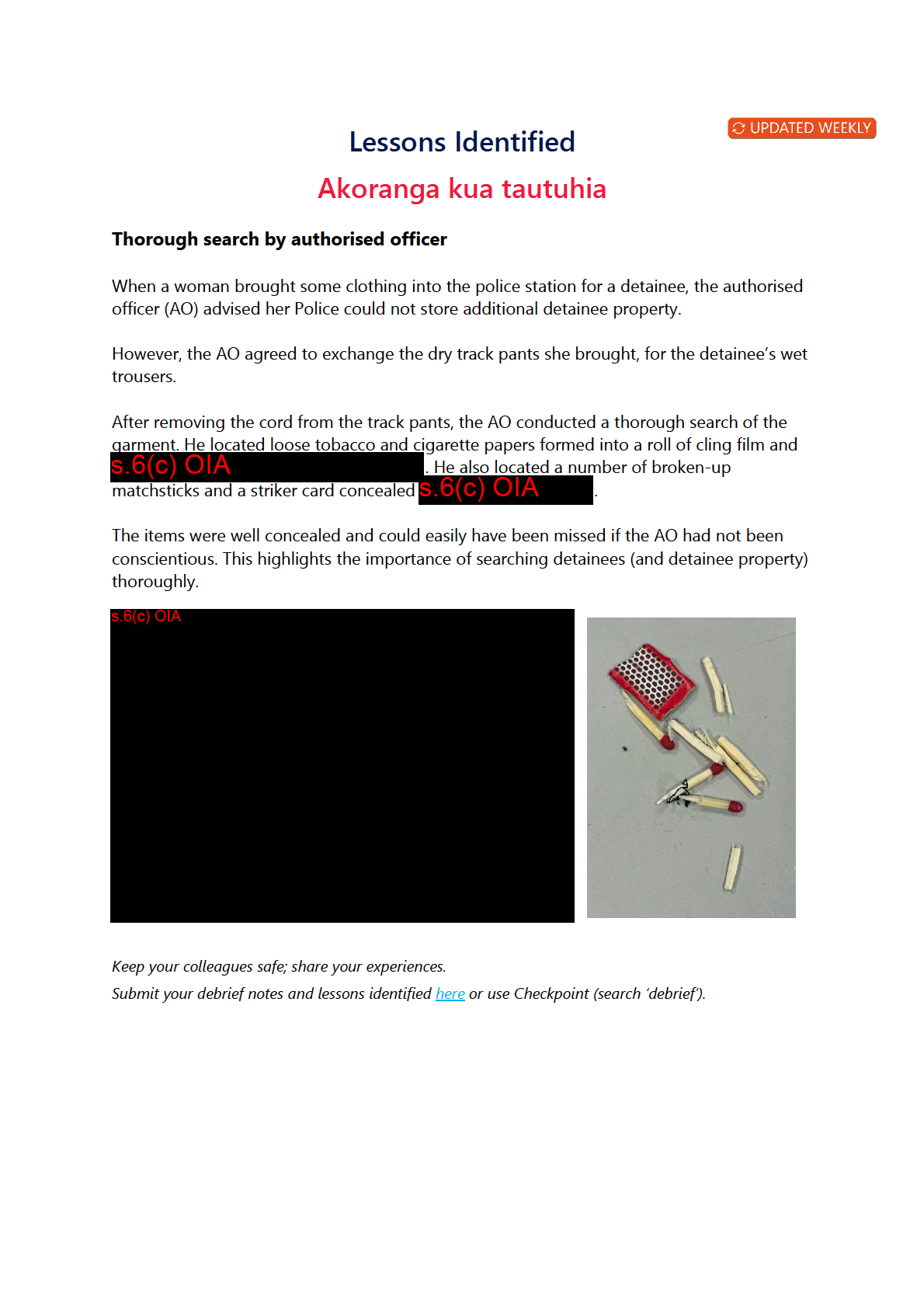
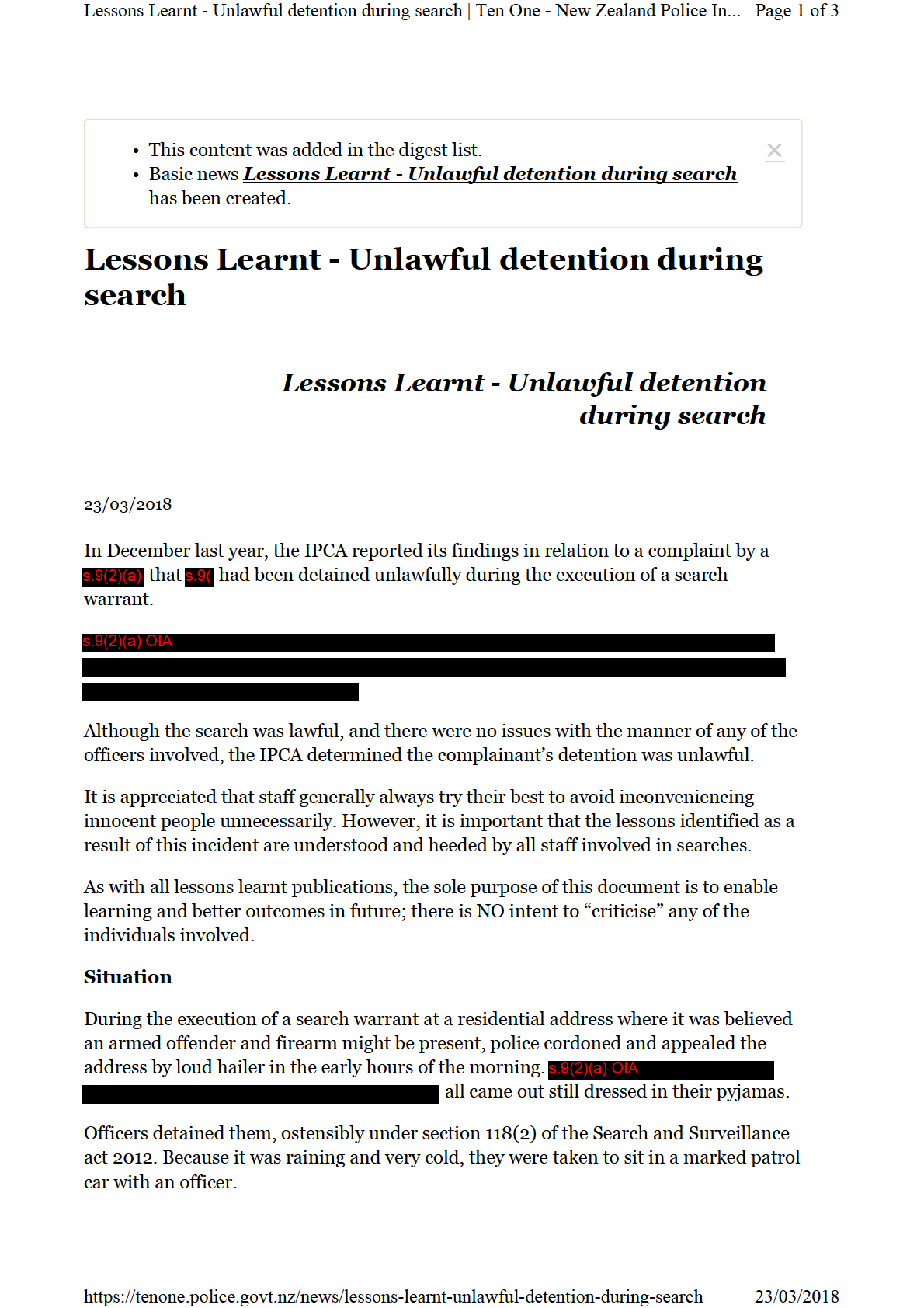
Lessons Learnt - Unlawful detention during search | Ten One - New Zealand Police In... Page 2 of 3
After spending several minutes in one marked patrol car, they were transferred to
another marked patrol car with another officer, who told them they were there purely
to keep warm and dry and out of the cold.
The officer also told them the reason for the warrant was because Police believed
property related to an alleged offender was at the house.
The s.9(2)(a) OIA
spent a total of approximately 1 hour and 15 minutes in the
marked patrol cars until officers had finished searching the house.
While they were in the car, the exhibit officer asked them questions about the
ownership of a mobile phone, and also advised them of their rights.
They were not asked any questions about their respective connection to the object of
the search.
Lessons Identified
Section 118 of the Search and Surveillance Act allows police to detain a person at the
place (or vehicle) being searched “…for the purpose of determining whether there is
any connection between [that person] and the object of the search…”
In this case, there was no attempt to establish any connection between the detained
people and the object of the search. Furthermore, as well as being detained, the
s.9(2)(a)
were excluded from the house.
OIA
Police can only exclude any person from a place being searched if it is believed (on
reasonable grounds) that they will obstruct or hinder the exercise of search powers
(S&S section 116).
The IPCA determined that the s.9(2)(a) OIA
were unlawfully detained
(in this case, for a period of 1hr and 15 minutes). Regardless of the officers’ intent to
keep them warm and dry, the detention of the s.9(2)(a) OIA
was nevertheless
unlawful.
Accepting the IPCA’s finding, Superintendent Anna Jackson, National Manager:
Professional Conduct, appreciates that staff acted with good intent. “However,” she
says, “It is important that we reflect on incidents like this, so we learn from them and
turn our mind to future strategies when conducting searches.”
Recommendations
Officers undertaking searches should endeavour to allow occupants back into an
address as soon as it has been secured and where it is physically practicable (e.g.
sufficient rooms available) for them to be present (and where they are not likely to
hinder or obstruct the search).
https://tenone.police.govt.nz/news/lessons-learnt-unlawful-detention-during-search
23/03/2018
Lessons Learnt - Unlawful detention during search | Ten One - New Zealand Police In... Page 3 of 3
If it is not practicable, Police should assist the occupants to find alternative locations,
such as relatives’ or friends’ houses to stay while the search is completed. In essence,
once people have been excluded and cleared of suspicion, they should be informed that
they are free to go about their business.
Part of the planning prior to executing a search warrant must include identifying where
occupants (if they are required to be excluded for some time) are to be taken while the
search is in progress.
Topics:
Frontline
Lessons Learnt
District:
National
https://tenone.police.govt.nz/news/lessons-learnt-unlawful-detention-during-search
23/03/2018
